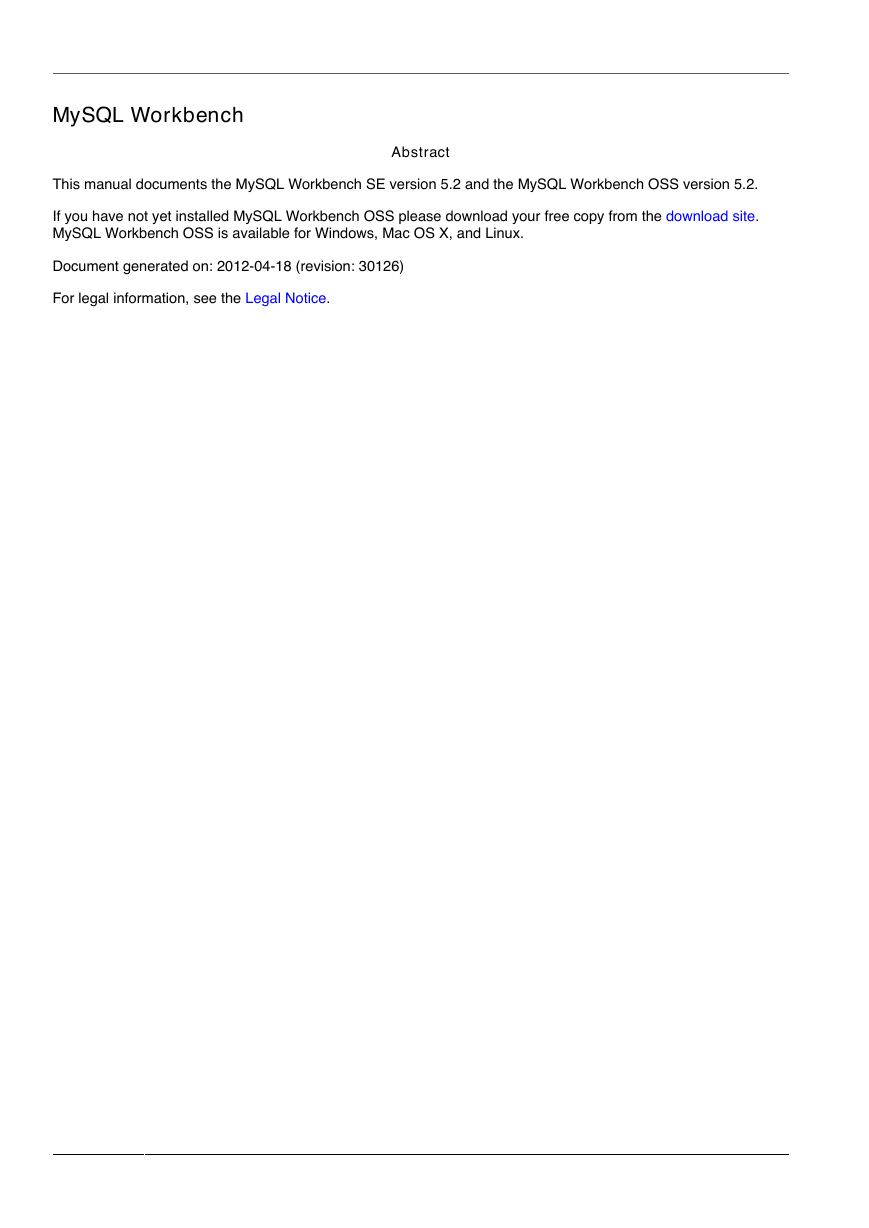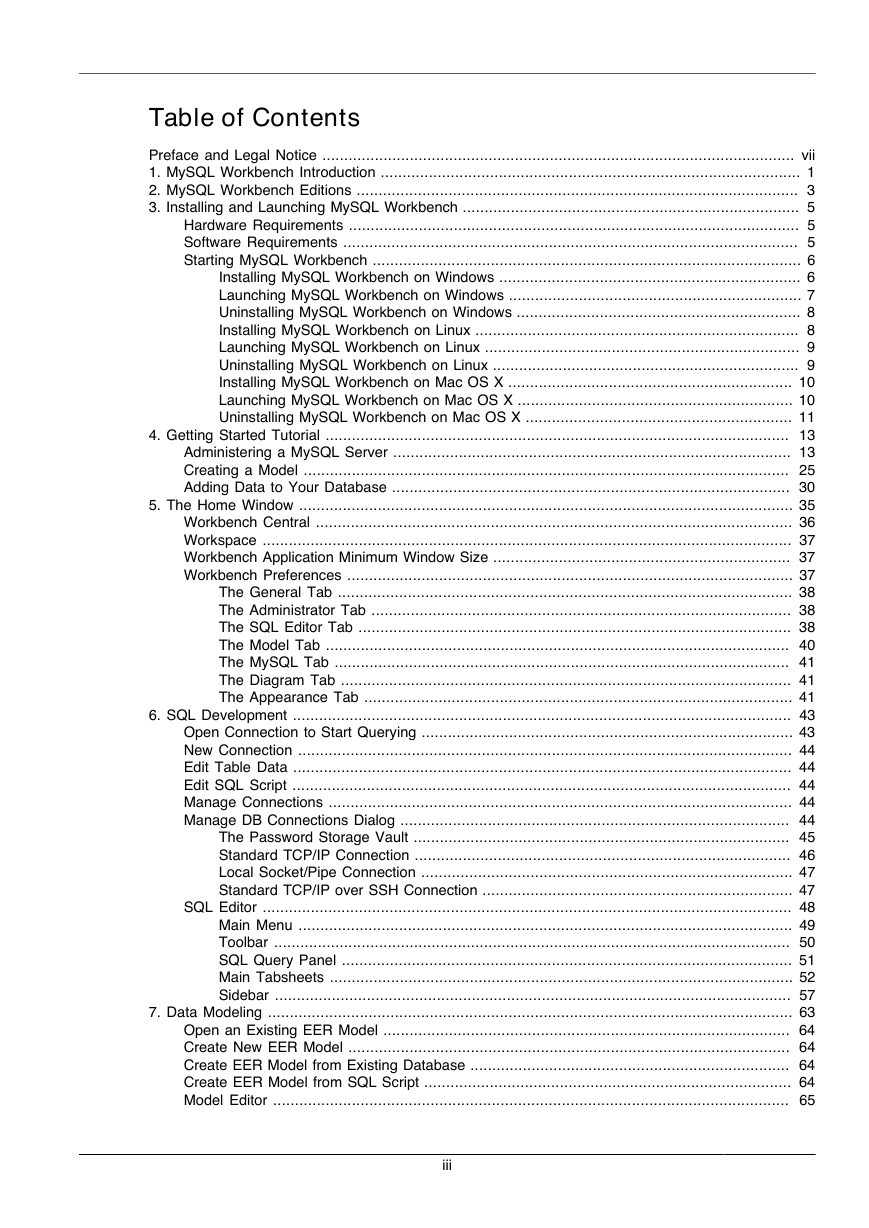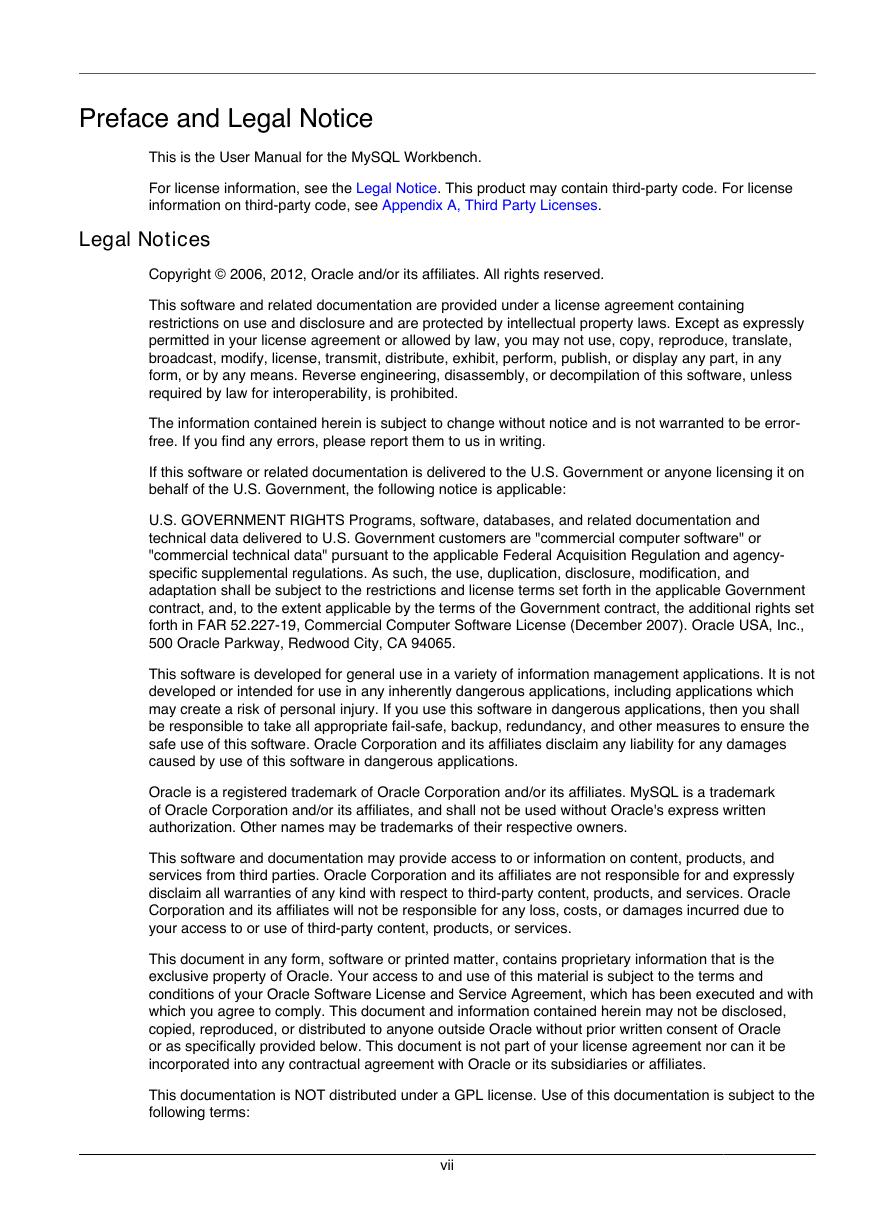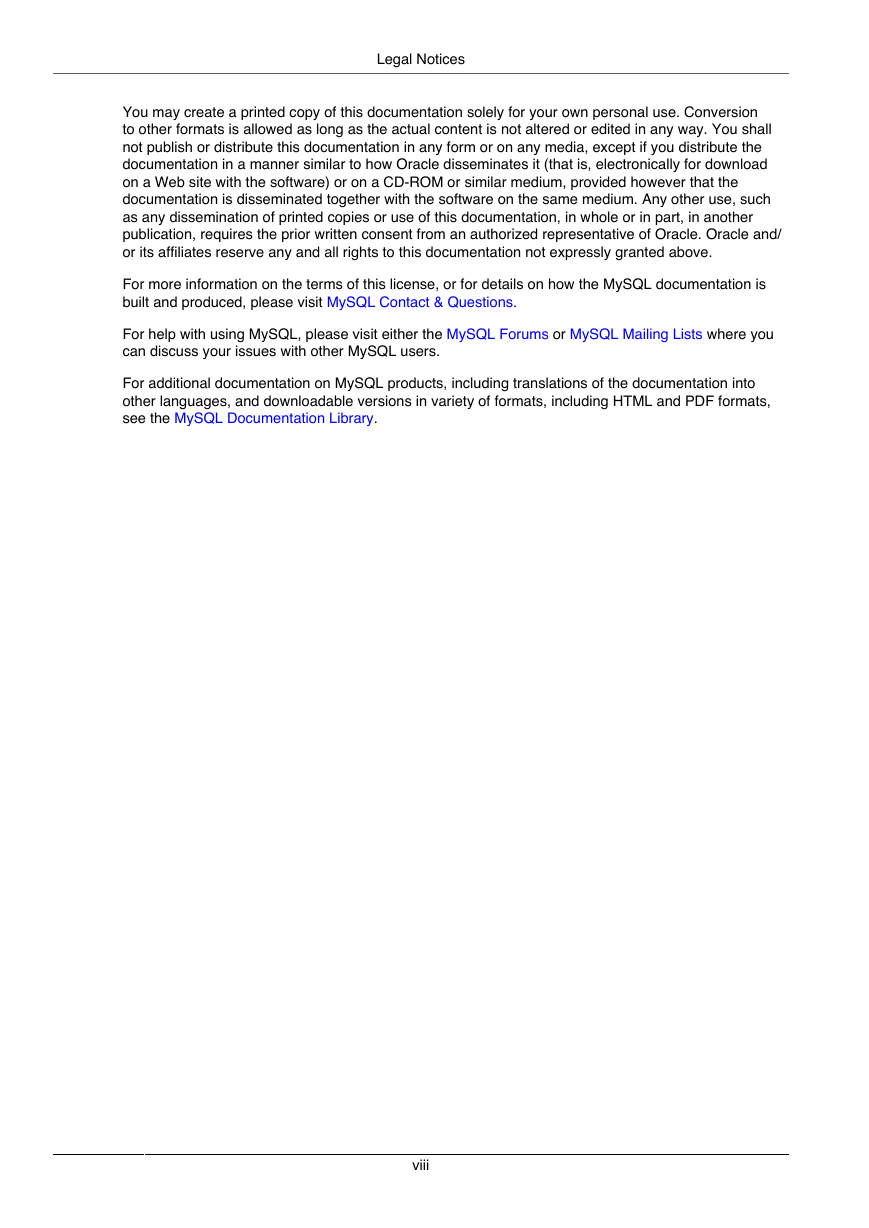MySQL Workbench
Table of Contents
Preface and Legal Notice
Chapter 1. MySQL Workbench Introduction
Chapter 2. MySQL Workbench Editions
Chapter 3. Installing and Launching MySQL Workbench
Hardware Requirements
Software Requirements
Starting MySQL Workbench
Installing MySQL Workbench on Windows
Launching MySQL Workbench on Windows
Uninstalling MySQL Workbench on Windows
Installing MySQL Workbench on Linux
Launching MySQL Workbench on Linux
Uninstalling MySQL Workbench on Linux
Installing MySQL Workbench on Mac OS X
Launching MySQL Workbench on Mac OS X
Uninstalling MySQL Workbench on Mac OS X
Chapter 4. Getting Started Tutorial
Administering a MySQL Server
Creating a Model
Adding Data to Your Database
Chapter 5. The Home Window
Workbench Central
Workspace
Workbench Application Minimum Window Size
Workbench Preferences
The General Tab
The Administrator Tab
The SQL Editor Tab
The Model Tab
The MySQL Tab
The Diagram Tab
The Appearance Tab
Chapter 6. SQL Development
Open Connection to Start Querying
New Connection
Edit Table Data
Edit SQL Script
Manage Connections
Manage DB Connections Dialog
The Password Storage Vault
Standard TCP/IP Connection
Local Socket/Pipe Connection
Standard TCP/IP over SSH Connection
SQL Editor
Main Menu
Toolbar
SQL Query Panel
Main Tabsheets
Output and History Tabsheet
Results Tabsheets
Live Editing Tabsheets
Sidebar
Snippets panel
Session and Object Information Panel
Object Browser
Chapter 7. Data Modeling
Open an Existing EER Model
Create New EER Model
Create EER Model from Existing Database
Create EER Model from SQL Script
Model Editor
Modeling Menus
The File Menu
The Edit Menu
Find Dialog Window
Workbench Preferences
The View Menu
The Arrange Menu
The Model Menu
The DBDoc Model Reporting Dialog Window (Commercial Version)
The Validation Submenus (Commercial Version)
The Object Notation Submenu
The Relationship Notation Submenu
The Database Menu
The Plugins Menu
The Scripting Menu
The Community Menu
The Help Menu
System Info
The Toolbar
Tool-Specific Toolbar Items
EER Diagrams
The Physical Schemata Panel
The Schema Objects Panel
The Schema Privileges Panel
Adding Roles
Adding Users
The SQL Scripts Panel
The Model Notes Panel
The History Palette
The Model Navigator Panel
The Catalog Tree Palette
The Layers Palette
Finding Invisible Objects Using the Layers Palette
The Properties Palette
EER Diagram Editor
The Vertical Toolbar
The Standard Mouse Pointer
The Hand Tool
The Eraser Tool
The Layer Tool
The Text Tool
The Image Tool
The Table Tool
The View Tool
The Routine Group Tool
The Relationship Tools
Working with Models
Creating Tables
Adding Tables to the Physical Schemata
Adding Tables to an EER Diagram
The MySQL Table Editor
The Main Editor Window
The Columns Tab
The Indexes Tab
The Foreign Keys Tab
The Triggers Tab
The Partitioning Tab
The Options Tab
The Inserts Tab
The Privileges Tab
Creating Foreign Key Relationships
Adding Foreign Key Relationships Using an EER Diagram
The Relationship Editor
Connection Properties
Creating Views
Adding Views to the Physical Schemata
Adding Views to an EER Diagram
The View Editor
Modifying a View Using the Properties Palette
Creating Routines and Routine Groups
Routines
Adding Routines to the Physical Schemata
The Routine Editor
The Routine Tab
The Privileges Tab
Routine Groups
Adding Routine Groups to the Physical Schemata
Adding Routine Groups to an EER Diagram
The Routine Group Editor
The Routine Groups Tab
The Privileges Tab
Modifying a Routine Group Using the Properties Palette
Creating Layers
Adding Layers to an EER Diagram
Adding Objects to a Layer
Modifying a Layer Using the Properties Palette
Creating Notes
Adding Notes
The Note Editor
Creating Text Objects
Adding Text Objects to an EER Diagram
The Text Object Editor
Modifying a Text Object Using the Properties Palette
Creating Images
Adding Images to an EER Diagram
The Image Editor
The Image Tab
Reverse Engineering
Reverse Engineering Using a Create Script
Reverse Engineering a Live Database
Errors During Reverse Engineering
Forward Engineering
Forward Engineering Using an SQL Script
Creating a Schema
Altering a Schema
Forward Engineering to a Live Server
Database Synchronization
Creating a Catalog Diff Report
Modeling Tutorials
Importing a Data Definition SQL Script
Adding an EER Diagram
Using the Default Schema
Creating a New Table
Creating Other Schema Objects
Basic Modeling
Adding a Table
Creating a Foreign Key
Documenting the sakila Database
A PNG File of the sakila Database
Printing
Printing Options
MySQL Workbench Schema Validation Plugins (Commercial Version)
General Validation
MySQL-Specific Validation
The DBDoc Model Reporting Dialog Window (Commercial Version)
Customizing DBDoc Model Reporting Templates
Supported Template Markers
Creating a Custom Template
Chapter 8. Server Administration
Server Administration
New Server Instance
Manage Data Import/Export
Manage Security
Manage Server Instances
Creating and Managing Server Instances
New Server Instance Wizard
Manage Server Instances Dialog
Server Administration and Configuration
The Startup Tab
The Configuration Tab
The Accounts Tab
Administrative Roles
The Connections Tab
The Variables Tab
The Data Dump Tab
Export to Disk
Import from Disk
Advanced Export Options
The Logs Tab
Chapter 9. Extending Workbench
GRT and Workbench Data Organization
Modules
Plugins
Adding a GUI to a Plugin Using MForms
The Workbench Scripting Shell
Exploring the Workbench Scripting Shell
The Shell Window
The Globals, Classes, and Modules Tabs
Tutorial: Writing Plugins
Chapter 10. Keyboard Shortcuts
Chapter 11. MySQL Utilities
Introduction
Introduction to MySQL Utilities
Connection Parameters
Introduction to extending the MySQL Utilities
Commands
mysql.utilities.command.grep — Search Databases for Objects
mysql.utilities.command.proc — Search Processes on Servers
Manual Pages
Brief overview of command-line utilities
mut - MySQL Utilities Testing
mysqldbcompare - Compare Two Databases and Identify Differences
mysqldbcopy - Copy Database Objects Between Servers
mysqldbexport - Export Object Definitions or Data from a Database
mysqldbimport - Import Object Definitions or Data into a Database
mysqldiff - Identify Differences Among Database Objects
mysqldiskusage - Show Database Disk Usage
mysqlfailover - Automatic replication health monitoring and failover
mysqlindexcheck - Identify Potentially Redundant Table Indexes
mysqlmetagrep - Search Database Object Definitions
mysqlprocgrep - Search Server Process Lists
mysqlreplicate - Set Up and Start Replication Between Two Servers
mysqlrpladmin - Administration utility for MySQL replication
mysqlrplcheck - Check Replication Prerequisities
mysqlrplshow - Show Slaves for Master Server
mysqlserverclone - Clone Existing Server to Create New Server
mysqlserverinfo - Display Common Diagnostic Information from a Server
mysqluserclone - Clone Existing User to Create New User
Parsers
mysql.utilities.parser — Parse MySQL Log Files
Appendix A. Third Party Licenses
.NET Flat TabControl License
Bitstream Vera License
Boost Library License
Cairo License
CTemplate (Google Template System) License
cURL (libcurl) License
DockPanel Suite License
Dojo Toolkit v1.7.0b1 License
GLib License (for MySQL Workbench)
Glitz License
GNU Lesser General Public License Version 2.1, February 1999
HtmlRenderer (System.Drawing.Html)
Libiconv License
Libintl License
Libxml2 License
Libzip License
Lua (liblua) License
Paramiko License
PCRE License
Pixman License
PyCrypto License
Python License
Scintilla License
ScintillaNET License
TinyXML License
TreeViewAdv for .NET License
VSQLite++ License
zlib License
Appendix B. MySQL Workbench FAQ
Appendix C. MySQL Workbench and Utilities Change History
MySQL Workbench Change History
Changes in Release 5.2
Changes in MySQL Workbench 5.2.40 (Not yet released)
Changes in MySQL Workbench 5.2.39 (10 April 2012)
Changes in MySQL Workbench 5.2.38 (23 February 2012)
Changes in MySQL Workbench 5.2.37 (26 December 2011)
Changes in MySQL Workbench 5.2.36 (3 December 2011)
Changes in MySQL Workbench 5.2.35 (23 September 2011)
Changes in MySQL Workbench 5.2.34 (26 May 2011)
Changes in MySQL Workbench 5.2.33b (21 March 2011)
Changes in MySQL Workbench 5.2.33 (11 March 2011)
Changes in MySQL Workbench 5.2.32 (05 March 2011)
Changes in MySQL Workbench 5.2.31a (13 December 2010)
Changes in MySQL Workbench 5.2.31 (08 December 2010)
Changes in MySQL Workbench 5.2.30 (20 November 2010)
Changes in MySQL Workbench 5.2.29 (12 October 2010)
Changes in MySQL Workbench 5.2.28 (19 September 2010)
Changes in MySQL Workbench 5.2.27 (01 September 2010)
Changes in MySQL Workbench 5.2.26 (06 August 2010)
Changes in MySQL Workbench 5.2.25 (30 June 2010, General Availability)
Changes in MySQL Workbench 5.2.24 (21 June 2010)
Changes in MySQL Workbench 5.2.23 (Internal release only)
Changes in MySQL Workbench 5.2.22 (02 June 2010)
Changes in MySQL Workbench 5.2.21 (12 May 2010, Release Candidate)
Changes in MySQL Workbench 5.2.20 (27 April 2010)
Changes in MySQL Workbench 5.2.19 (16 April 2010)
Changes in MySQL Workbench 5.2.18 (13 April 2010)
Changes in MySQL Workbench 5.2.17 (02 April 2010)
Changes in MySQL Workbench 5.2.16 (17 February 2010)
Changes in MySQL Workbench 5.2.15 (28 January 2010)
Changes in MySQL Workbench 5.2.14 (21 January 2010)
Changes in MySQL Workbench 5.2.13 (Not released)
Changes in MySQL Workbench 5.2.12 (Not released)
Changes in MySQL Workbench 5.2.11 (18 December 2009)
Changes in MySQL Workbench 5.2.10 (01 December 2009)
Changes in MySQL Workbench 5.2.9 (Internal release only)
Changes in MySQL Workbench 5.2.8 (18 November 2009, Beta)
Changes in MySQL Workbench 5.2.7 (Internal release only)
Changes in MySQL Workbench 5.2.6 (21 October 2009)
Changes in MySQL Workbench 5.2.5 (Internal Release Only)
Changes in MySQL Workbench 5.2.4 (07 October 2009)
Changes in MySQL Workbench 5.2.3 (15 September 2009)
Changes in MySQL Workbench 5.2.2 (27 July 2009)
Changes in MySQL Workbench 5.2.1 (22 May 2009)
Changes in MySQL Workbench 5.2.0 (30 April 2009, Alpha)
Changes in Release 5.1
Changes in MySQL Workbench 5.1.19 (06 September 2010)
Changes in MySQL Workbench 5.1.18 (03 September 2009, General Availability)
Changes in MySQL Workbench 5.1.17 (14 August 2009)
Changes in MySQL Workbench 5.1.16 (30 June 2009, General Availability)
Changes in MySQL Workbench 5.1.15 (26 June 2009)
Changes in MySQL Workbench 5.1.14 (19 June 2009)
Changes in MySQL Workbench 5.1.13 (12 June 2009)
Changes in MySQL Workbench 5.1.12 (27 April 2009)
Changes in MySQL Workbench 5.1.11 (Not yet released)
Changes in MySQL Workbench 5.1.10 (10 April 2009)
Changes in MySQL Workbench 5.1.9 (Not yet released, Beta)
Changes in MySQL Workbench 5.1.8 (Not yet released)
Changes in MySQL Workbench 5.1.7 (Not yet released)
Changes in MySQL Workbench 5.1.6 (Not yet released)
Changes in MySQL Workbench 5.1.4 (Not yet released)
Changes in Release 5.0
Changes in MySQL Workbench 5.0.30 (18 February 2009)
Changes in MySQL Workbench 5.0.29 (12 December 2008)
Changes in MySQL Workbench 5.0.28 (06 December 2008)
Changes in MySQL Workbench 5.0.27 (07 November 2008)
Changes in MySQL Workbench 5.0.26 (16 October 2008)
Changes in MySQL Workbench 5.0.25 (12 September 2008)
Changes in MySQL Workbench 5.0.24 (12 August 2008)
Changes in MySQL Workbench 5.0.23 (25 June 2008)
Changes in MySQL Workbench 5.0.22 (27 May 2008)
Changes in MySQL Workbench 5.0.21 (27 April 2008)
Changes in MySQL Workbench 5.0.20 (26 April 2008)
Changes in MySQL Workbench 5.0.19 (15 April 2008)
Changes in MySQL Workbench 5.0.18rc (not released)
Changes in MySQL Workbench 5.0.17rc (07 April 2008)
Changes in MySQL Workbench 5.0.16rc (26 March 2008)
Changes in MySQL Workbench 5.0.15rc (17 March 2008)
Changes in MySQL Workbench 5.0.14abeta (28 February 2008)
Changes in MySQL Workbench 5.0.14beta (25 February 2008)
MySQL Utilities Change History
Changes in Release 1.0
Changes in MySQL Utilities 1.0.5 (10 April 2012)
Changes in MySQL Utilities 1.0.4 (22 December 2011)
Changes in MySQL Utilities 1.0.3 (10 October 2011)
Changes in MySQL Utilities 1.0.2 (12 August 2011)
Changes in MySQL Utilities 1.0.1 (11 May 2011)
Changes in MySQL Utilities 1.0.0 (07 December 2010)
















 2023年江西萍乡中考道德与法治真题及答案.doc
2023年江西萍乡中考道德与法治真题及答案.doc 2012年重庆南川中考生物真题及答案.doc
2012年重庆南川中考生物真题及答案.doc 2013年江西师范大学地理学综合及文艺理论基础考研真题.doc
2013年江西师范大学地理学综合及文艺理论基础考研真题.doc 2020年四川甘孜小升初语文真题及答案I卷.doc
2020年四川甘孜小升初语文真题及答案I卷.doc 2020年注册岩土工程师专业基础考试真题及答案.doc
2020年注册岩土工程师专业基础考试真题及答案.doc 2023-2024学年福建省厦门市九年级上学期数学月考试题及答案.doc
2023-2024学年福建省厦门市九年级上学期数学月考试题及答案.doc 2021-2022学年辽宁省沈阳市大东区九年级上学期语文期末试题及答案.doc
2021-2022学年辽宁省沈阳市大东区九年级上学期语文期末试题及答案.doc 2022-2023学年北京东城区初三第一学期物理期末试卷及答案.doc
2022-2023学年北京东城区初三第一学期物理期末试卷及答案.doc 2018上半年江西教师资格初中地理学科知识与教学能力真题及答案.doc
2018上半年江西教师资格初中地理学科知识与教学能力真题及答案.doc 2012年河北国家公务员申论考试真题及答案-省级.doc
2012年河北国家公务员申论考试真题及答案-省级.doc 2020-2021学年江苏省扬州市江都区邵樊片九年级上学期数学第一次质量检测试题及答案.doc
2020-2021学年江苏省扬州市江都区邵樊片九年级上学期数学第一次质量检测试题及答案.doc 2022下半年黑龙江教师资格证中学综合素质真题及答案.doc
2022下半年黑龙江教师资格证中学综合素质真题及答案.doc